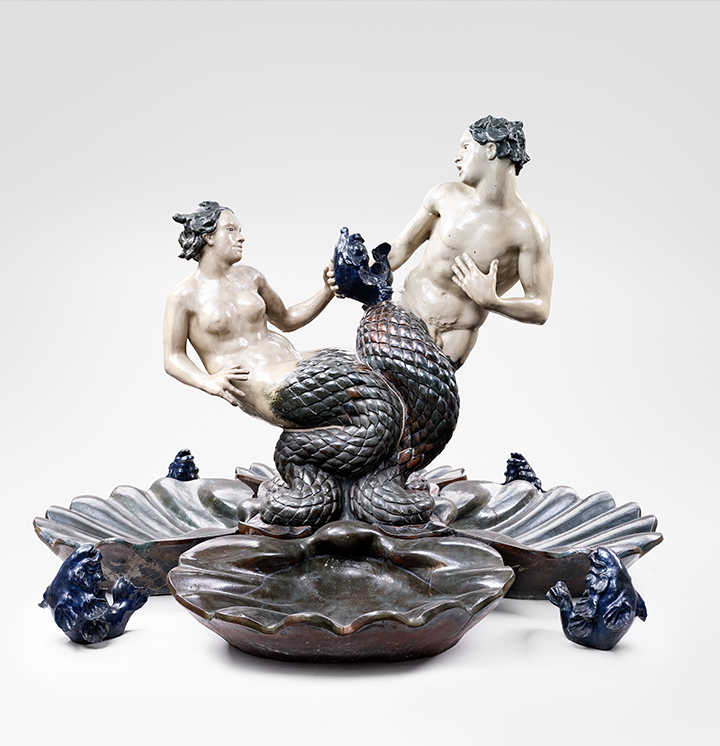JEAN GAUGUIN & CERAMICS
On 8 May 2025, Ordrupgaard opened its doors to a new exhibition about Jean Gauguin and ceramic art. The museum recently received a private donation of nine ceramic sculptures and, with the existing works, now has a significant collection of the Danish-French sculptor Jean René Gauguin (1881–1961). The works are displayed together for the very first time in a permanent exhibition in the iconic wing built by Zaha Hadid. Here scenographer Stine Friese has created a sensory and mythological universe peopled with marine creatures, grotesque figures, and fabulous animals, presenting Gauguin as a brilliant innovator of ceramic art and among the most prominent figures of art deco.
Ordrupgaard houses one of the country’s most important collections of Jean Gauguin’s works. The founding couple, Henny and Wilhelm Hansen, had already noticed the talent of this sculptor and therefore commissioned the major work Merman and Mermaid (1927/28) specially for Ordrupgaard. Since then, more of Gauguin’s works were added and, in 2023, the museum received a generous donation from Jean-Paul Guintrand in memory of the art dealer Jørgen L. Dalgaard. As a result, the exhibition presents the artist’s ceramic works, a veritable string of pearls and all of them created at the porcelain factory Bing & Grøndahl, where Gauguin worked for several decades, starting in 1923. The exhibition features works in porcelain, tin-glazed earthenware, and stoneware.
MAJOR CERAMIC WORK AT THE HEART OF THE EXHIBITION
The central work in the exhibition is the monumental fountain sculpture Merman and Mermaid acquired to celebrate the sixtieth birthday of the founder Wilhelm Hansen in 1928. This sensational sculpture which, at the time, was described as the ’biggest porcelain work in the world’ was originally a fountain placed in the rose garden at Ordrupgaard, where fabulous animals affectionately compete for a fish emitting cascades of water from its mouth.
The sculptural group comprising marine gods (tritons), half human and half fish, along with enormous ceramic mussel shells paraphrases the Italian sculptor Giovanni Lorenzo Bernini’s famous Triton Fountain (1642‒43) in Rome. With great audacity, Gauguin challenges the elasticity of clay in a giant format, creating both dynamism and drama in the sensual competition depicted in the figural group. Merman and Mermaid is a great artistic and technical achievement. The work, underway for eighteen months, weighs around one ton, and the main figure consists of only three parts that, after a difficult firing process, was assembled to form a whole.
For reasons of preservation, the sculptural group has long since ceased to function as a fountain and has therefore been placed at different locations in the house. In the exhibition, it is presented quite freely and unencumbered in the room thus coming into its own completely.
NEW WORKS BY JEAN GAUGUIN FOR ORDRUPGAARD
In the exhibition, Merman and Mermaid is accompanied by the museum’s other sculptures by Gauguin, including nine new works donated by Jean-Paul Guintrand in memory of Jørgen L. Dalgaard, along with the sculpture Silenus, n.d., recently acquired by the museum. These works include both human figures and animals in motion, hinting at Gauguin’s talent for balancing the mythical with the tangible and the fragile with the grotesque. The usually paradoxical relationship between the motifs and the delicate material lends the motifs a unique power to fascinate – characteristic of the exhibition generally.
Moreover, the exhibition directs focus at Gauguin’s ingenious and imaginative tin-glazed earthenware works, created following a prolonged work stay in the Sèvres porcelain factory outside Paris. This inspired him to work with tin-glazed earthenware at Bing & Grøndahl. The recently acquired Silenus belongs, along with The Kiss (1927) and Cresting Waves, n.d., also featured in the exhibition, among the ten tin-glazed earthenware groups created in 1927 after his return. The figures are decorated with colours by the artist’s younger brother, Pola Gauguin (1883–1961).
A PIONEERING INNOVATOR OF CERAMIC ART
Jean Gauguin was the son of Danish Mette Gauguin (1850–1920), née Gad, and the French painter Paul Gauguin (1848–1903). The latter is also central to the Ordrupgaard collection, which includes, for example, a wax bust of Jean Gauguin as a baby. Jean Gauguin was born in Paris but grew up in Copenhagen, where he became a cabinetmaker and later worked as a self-taught sculptor. A life-long interest in the expressional possibilities of materials made him experiment with a broad spectrum of media. To begin with, he worked primarily with wood and bronze. Eventually, he devoted himself to clay, and it was as innovator of ceramic art that Gauguin truly made his name.
JEAN GAUGUIN & CERAMIC ART
With the addition of ten new works by Jean Gauguin, Ordrupgaard now has a total of thirteen ceramic works, which is why the exhibition Jean Gauguin & Ceramics provides a unique glimpse of the artist’s oeuvre, marked by both French art and Nordic design traditions. Gauguin is thus naturally anchored at the museum where his works revive historical links, presenting him as a brilliant innovator of ceramic art. In future, this part of the collection, hitherto underexposed, will form a permanent exhibition in a gallery space in the Zaha Hadid wing.
The exhibition is staged by Stine Friese, scenographer, in collaboration with Malene Anton, art registrar at Ordrupgaard, and Rikke Zinck Jensen, curator. The staging subtly recalls art deco, while the varying heights of the bases and choice of materials highlight the playful and rhythmic element in Gauguin’s design.
FOUNDATIONS
The exhibition has received generous financial support from Jørgen Krygers og Anne Ammitzbølls Fond as well as Lizzie og Ejler Ruges Kunstfond.
